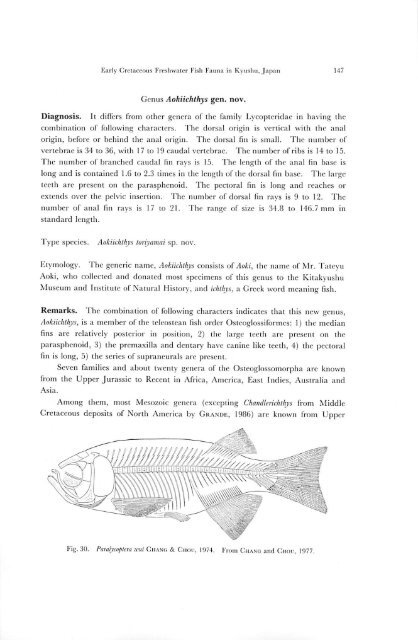Early Cretaceous Freshwater Fish Fauna in Kyushu, Japan
Early Cretaceous Freshwater Fish Fauna in Kyushu, Japan
Early Cretaceous Freshwater Fish Fauna in Kyushu, Japan
You also want an ePaper? Increase the reach of your titles
YUMPU automatically turns print PDFs into web optimized ePapers that Google loves.
<strong>Early</strong> <strong>Cretaceous</strong> <strong>Freshwater</strong> <strong>Fish</strong> <strong>Fauna</strong> <strong>in</strong> <strong>Kyushu</strong>. <strong>Japan</strong> 147<br />
Genus Aokiichthys gen. nov.<br />
Diagnosis. It differs from other genera of the family Lycopteridae <strong>in</strong> hav<strong>in</strong>g the<br />
comb<strong>in</strong>ation of follow<strong>in</strong>g characters. The dorsal orig<strong>in</strong> is vertical with the anal<br />
orig<strong>in</strong>, before or beh<strong>in</strong>d the anal orig<strong>in</strong>. The dorsal f<strong>in</strong> is small. The number of<br />
vertebrae is 34 to 36, with 17 to 19 caudal vertebrae. The number of ribs is 14 to 15.<br />
The number of branched caudal f<strong>in</strong> rays is 15. The length of the anal f<strong>in</strong> base is<br />
long and is conta<strong>in</strong>ed 1.6 to 2.3 times <strong>in</strong> the length of the dorsal f<strong>in</strong> base. The large<br />
teeth are present on the parasphenoid. The pectoral f<strong>in</strong> is long and reaches or<br />
extends over the pelvic <strong>in</strong>sertion. The number of dorsal f<strong>in</strong> rays is 9 to 12. The<br />
number of anal f<strong>in</strong> rays is 17 to 21. The range of size is 34.8 to 146.7 mm <strong>in</strong><br />
standard length.<br />
Type species.<br />
Aokiichthys toriyamai sp. nov.<br />
Etymology. The generic name, Aokiichthys consists of Aoki, the name of Mr. Tateyu<br />
Aoki, who collected and donated most specimens of this genus to the Kitakyushu<br />
Museum and Institute of Natural History, and ichthys, a Greek word mean<strong>in</strong>g fish.<br />
Remarks. The comb<strong>in</strong>ation of follow<strong>in</strong>g characters <strong>in</strong>dicates that this new genus,<br />
Aokiichthys, is a member of the teleostean fish order Osteoglossiformes: 1) the median<br />
f<strong>in</strong>s are relatively posterior <strong>in</strong> position, 2) the large teeth arc present on the<br />
parasphenoid, 3) the premaxilla and dentary have can<strong>in</strong>e like teeth, 4) the pectoral<br />
f<strong>in</strong> is long, 5) the scries of supraneurals are present.<br />
Seven families and about twenty genera of the Osteoglossomorpha are known<br />
from the Upper Jurassic to Recent <strong>in</strong> Africa, America, East Indies, Australia and<br />
Asia.<br />
Among them, most Mesozoic genera (except<strong>in</strong>g Chandlerichlhys from Middle<br />
<strong>Cretaceous</strong> deposits of North America by Grande, 1986) are known from Upper<br />
#?<br />
Fig. 30. Paralycoptera wui Chang &Chou, 1974. From Chang and Chou, 1977.

















